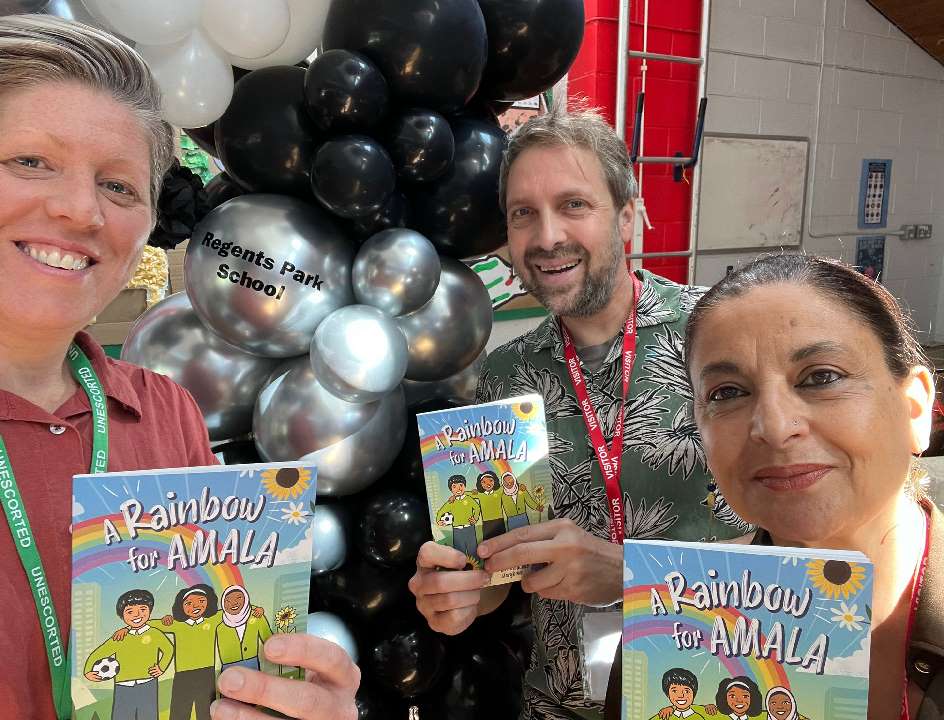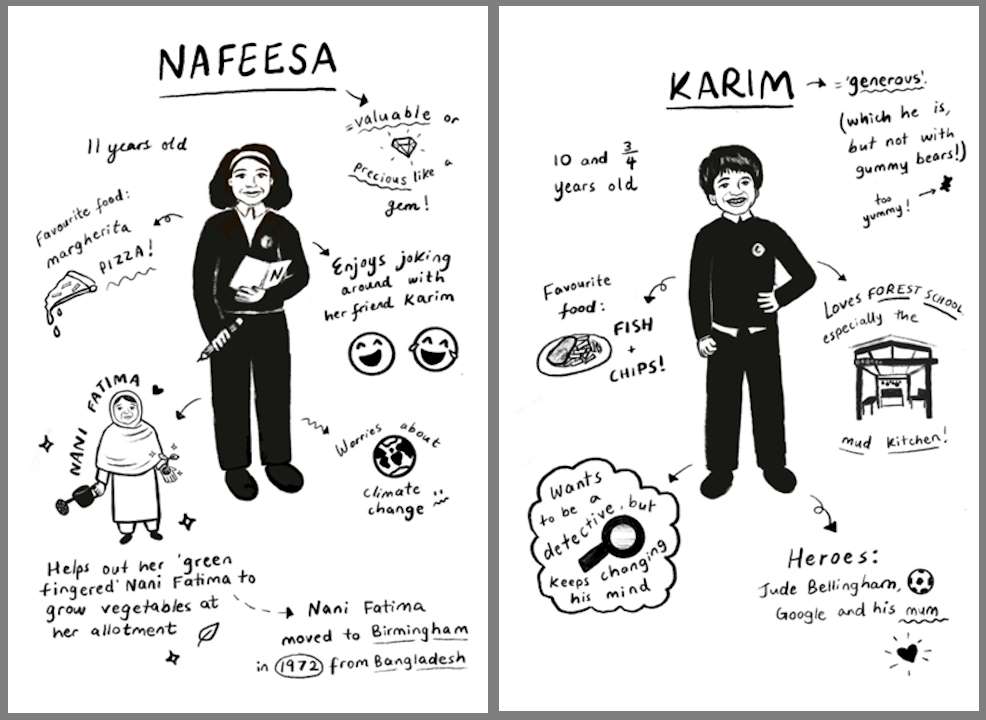Project Retrospective: Interactive Puzzle Book
So, it turns out that I did actually write a bit about ‘A Rainbow for Amala’ back in 2022, which is when we produced a prototype version of the game. You can still download that PDF to play the prototype and read the blogpost here.

Just to remind you, ‘A Rainbow for Amala’ is… an interactive story book that wants to save the world!
Join Nafeesa and her best friend Karim as they set out on a quest to befriend the quiet new girl Amala. What will give her back her smile? Use your phone or tablet as you read the story to listen to their conversations, help them solve puzzles, crack codes and become part of their journey to uncover the truth.
TLDR; We published a book (2 years later)!
This is something we’re very proud of, especially because it exists in a somewhat permanent form. Many of my projects are showcased at festivals, conferences, and pop-ups, or take other temporary forms, so creating something that people can enjoy for years to come feels particularly special.
We were fortunate to receive further funding from the Arts Council, allowing us to complete the full digital interactive puzzle book.

Sudha Bhuchar, our multi-talented writer, is currently staring in Bradford-based BBC Crime Drama, Virdee, where she plays the Yorkshire mum, Jyoti Virdee. We were lucky that she could fit A Rainbow for Amala around her acting roles.
Katie Day, is currently completing a PhD in Immersive Theatre related to Climate Change at the University of Birmingham. Or, if you prefer the full thesis title: Scenarios for change: new interdisciplinary dramaturgies of immersion, interactivity and affect in the context of climate and ecological breakdown.
A Tale of Two Deadlines
As will come as no surprise to exactly no one, our funding was only a fraction of what we actually needed to complete the production. The bad news being that we didn’t have any access to further funds.
Our original timeline had us wrapping the project up around early May, but in reality, it was only finished around early September - just a touch behind schedule.
However, we did have a real deadline that we set ourselves of early July. We wanted the Year 6 children from Regent’s Park Primary School, who had been heavily involved in the earlier development, to receive a finished copy of the book before they moved on to secondary school, where they would become harder to reach.
We were very lucky to work with the same children who were originally involved in the prototype stage (when they were in Year 4). This was important to us, not just because they were already familiar with the project, but because the stories in the book are based on personal stories they shared with us.
Celebration with Regent’s Primary
So, in early July 2024, armed with 150 printed copies of the book, we visited Regent’s Park Primary School for the final time. We organised a celebration and picnic for the children and their families, where we distributed copies of the book. This event felt like the true launch of the project.
But, as I mentioned, the book wasn’t actually released properly until September. What do I mean by that? The book itself was published in hard format, but as you may remember, it’s full of QR codes that point to online content. At that point, the QR codes were still pointing to placeholder content - mainly the animation sections of the game, as well as protoypes of the the digital games I had built.
Why the Delay?
Ultimately, the delays were due to the interlinked dependencies throughout the book. The story, digital games, artwork, audio recordings and animations all depend on each other. A tweak to one element would cause alterations in the others. It was very much like an iterative game development process. It made sense to leave the most costly parts of development - the animations and digital games - until the end. It would have been much more expensive to repeatedly go back to the animator to request updates or in the worst case discard their work, and request new animations.
For example: the animations depended on the audio recordings, which required actors to perform them, and that required finalised scripts. A small script change could cause knock-on effects in the audio recordings and, consequently, in the animations.
At the same time - it’s the physical printing of the book that is so final. We were printing in small batches of around 150. So, any errors or alterations would send that batch to the recycling - not ideal for a book with a climate change message.
We were slightly more fortunate with the digital games, since I was building them myself, and my time on the project was essentially unlimited (!!!). Early on, we created placeholder versions of the games, which we could refine based on feedback. We also delayed handling cross-platform issues to ensure the games ran smoothly in mobile browsers.
A Taste of things:
You can buy the book here :)
While you are waiting for your copy to arrive here are some digital examples to entertain you. Firstly, Amala’s two friend’s Nafessa and Karim act as player guide throughout the story.

Here are a couple of pages from the book - showing QR codes which link to the digital content. Even though the QR codes appear small they should still scan fine on your phone.

If you’re on a mobile device, scanning QR codes might be tricky. So click these links instead.
Animation of speaking to Miss Anwar
Native vs Web Apps
There are many engines that support mobile game development, the most obvious being Unity. However, these engines are primarily designed for creating native apps. While native apps still make sense for larger mobile games - since people are generally willing to do a one-time install - we’ve seen a shift towards web apps, which essentially function like mobile applications without requiring installation.
The big benefit of web apps, of course, is the ease of access - no installation, no permissions - just instant gameplay.
For games, native OS features can be very useful, so building games as native apps has clear advantages. This creates further challenges when trying to replicate that behavior in a mobile web app. e.g. even playing sounds is something that browsers will try to prevent you doing (thank you Safari cough, cough!)
From a technical perspective, the games were either built in pure HTML5 or using the Q5.js library. If you’re familiar with Processing, Q5.js is a lightweight version of the p5.js library that makes it easiy to write Processing code for the web. I also explored slightly larger game engines such as Phaser, p5.play, pixiJS, and melonJS. However, in order to keep the content lightweight, I found it more efficient to develop my own libraries.
Looking back at the project now, I’ve finally made a shift towards using TypeScript instead of JavaScript. If I were to revisit this project, I would start from that perspective. Among the libraries I evaluated, MelonJS was the only one small enough to make sense for mobile game development in a browser.
Thanks
As is typical of these underfunded projects - everyone went well above and beyond what we were able to pay them. Massive thanks to our producer Rachael Burton, typesetter Adam York Gregory, animator Zuhair Mehrali and graphic designer Niels Dielen. Huge thanks to everyone else who made it happen and those who worked on earlier iterations too - especially the children and teachers of Regent’s Park Primary School!
An immersive experience disguised as a book!
Doing something for the first time always exposes your limited knowledge on a topic. In my head, self-publishing a book was one of the easier pieces of content to make. Partly, and quite obviously, we under-estimated the work required. However, we also fell foul of a mistake we’ve made in the past - trying to create an experience in a different medium. A Rainbow for Amala is a collaborative, digital, interactive, immersive experience that we’ve disguised as a published book! So, we faced all the new issues of self-publishing a book for the first time - along with the usual challenges of interactive, digital, immersive experiences! And we wonder why we never have enough money!
You can buy a copy of the book here.
And once you’ve finished it - please do pass it on. It’s designed as a book to be shared and it’s positive messages to be passed forward.
You can start your own journey as a **Climate Activist here.
And you can see the talk we gave on it at Immersive Experience Network Summit in October 2024:
